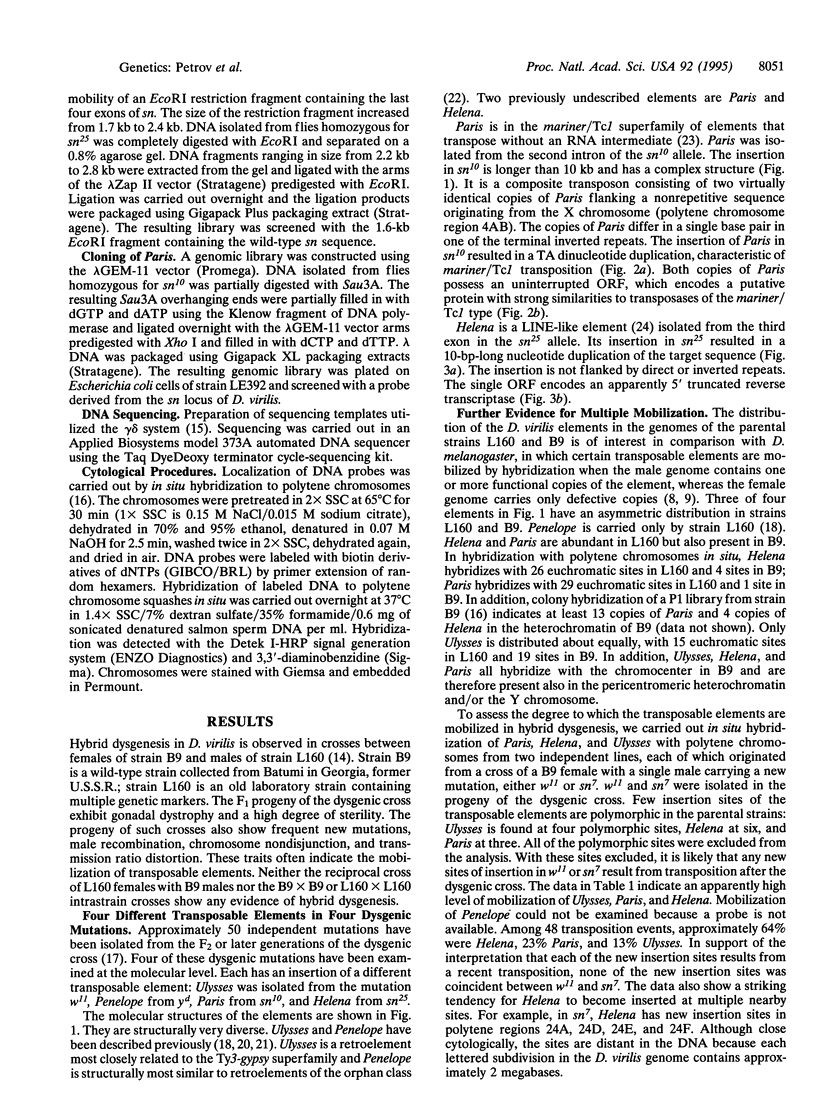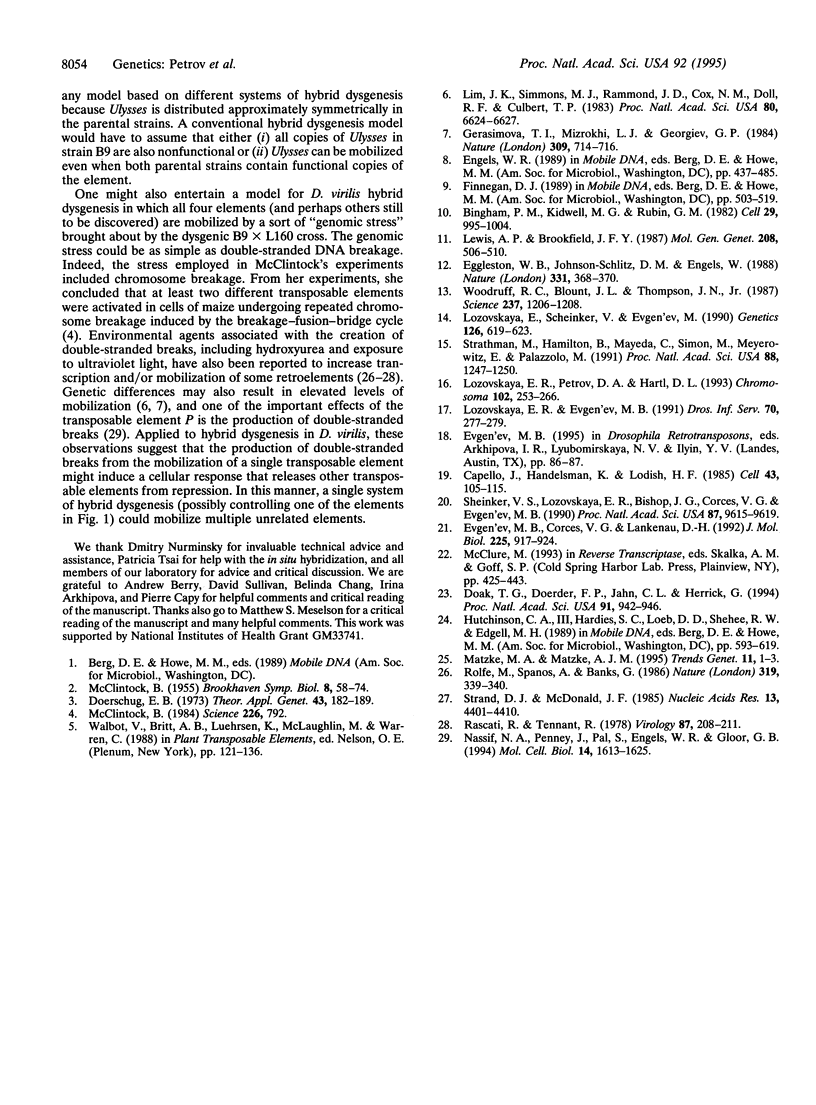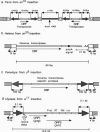Abstract
We describe a system of hybrid dysgenesis in Drosophila virilis in which at least four unrelated transposable elements are all mobilized following a dysgenic cross. The data are largely consistent with the superposition of at least three different systems of hybrid dysgenesis, each repressing a different transposable element, which break down following the hybrid cross, possibly because they share a common pathway in the host. The data are also consistent with a mechanism in which mobilization of a single element triggers that of others, perhaps through chromosome breakage. The mobilization of multiple, unrelated elements in hybrid dysgenesis is reminiscent of McClintock's evidence [McClintock, B. (1955) Brookhaven Symp. Biol. 8, 58-74] for simultaneous mobilization of different transposable elements in maize.
Full text
PDF




Images in this article
Selected References
These references are in PubMed. This may not be the complete list of references from this article.
- Bingham P. M., Kidwell M. G., Rubin G. M. The molecular basis of P-M hybrid dysgenesis: the role of the P element, a P-strain-specific transposon family. Cell. 1982 Jul;29(3):995–1004. doi: 10.1016/0092-8674(82)90463-9. [DOI] [PubMed] [Google Scholar]
- Cappello J., Handelsman K., Lodish H. F. Sequence of Dictyostelium DIRS-1: an apparent retrotransposon with inverted terminal repeats and an internal circle junction sequence. Cell. 1985 Nov;43(1):105–115. doi: 10.1016/0092-8674(85)90016-9. [DOI] [PubMed] [Google Scholar]
- Doak T. G., Doerder F. P., Jahn C. L., Herrick G. A proposed superfamily of transposase genes: transposon-like elements in ciliated protozoa and a common "D35E" motif. Proc Natl Acad Sci U S A. 1994 Feb 1;91(3):942–946. doi: 10.1073/pnas.91.3.942. [DOI] [PMC free article] [PubMed] [Google Scholar]
- Eggleston W. B., Johnson-Schlitz D. M., Engels W. R. P-M hybrid dysgenesis does not mobilize other transposable element families in D. melanogaster. Nature. 1988 Jan 28;331(6154):368–370. doi: 10.1038/331368a0. [DOI] [PubMed] [Google Scholar]
- Evgen'ev M. B., Corces V. G., Lankenau D. H. Ulysses transposable element of Drosophila shows high structural similarities to functional domains of retroviruses. J Mol Biol. 1992 Jun 5;225(3):917–924. doi: 10.1016/0022-2836(92)90412-d. [DOI] [PubMed] [Google Scholar]
- Lim J. K., Simmons M. J., Raymond J. D., Cox N. M., Doll R. F., Culbert T. P. Homologue destabilization by a putative transposable element in Drosophila melanogaster. Proc Natl Acad Sci U S A. 1983 Nov;80(21):6624–6627. doi: 10.1073/pnas.80.21.6624. [DOI] [PMC free article] [PubMed] [Google Scholar]
- Lozovskaya E. R., Petrov D. A., Hartl D. L. A combined molecular and cytogenetic approach to genome evolution in Drosophila using large-fragment DNA cloning. Chromosoma. 1993 Mar;102(4):253–266. doi: 10.1007/BF00352399. [DOI] [PubMed] [Google Scholar]
- Lozovskaya E. R., Scheinker V. S., Evgen'ev M. B. A hybrid dysgenesis syndrome in Drosophila virilis. Genetics. 1990 Nov;126(3):619–623. doi: 10.1093/genetics/126.3.619. [DOI] [PMC free article] [PubMed] [Google Scholar]
- MCCLINTOCK B. Intranuclear systems controlling gene action and mutation. Brookhaven Symp Biol. 1956 Feb;(8):58–74. [PubMed] [Google Scholar]
- Matzke M. A., Matzke A. J. Homology-dependent gene silencing in transgenic plants: what does it really tell us? Trends Genet. 1995 Jan;11(1):1–3. doi: 10.1016/s0168-9525(00)88973-8. [DOI] [PubMed] [Google Scholar]
- McClintock B. The significance of responses of the genome to challenge. Science. 1984 Nov 16;226(4676):792–801. doi: 10.1126/science.15739260. [DOI] [PubMed] [Google Scholar]
- Nassif N., Penney J., Pal S., Engels W. R., Gloor G. B. Efficient copying of nonhomologous sequences from ectopic sites via P-element-induced gap repair. Mol Cell Biol. 1994 Mar;14(3):1613–1625. doi: 10.1128/mcb.14.3.1613. [DOI] [PMC free article] [PubMed] [Google Scholar]
- Rascati R. J., Tennant R. W. Induction of endogenous murine retrovius by hydroxyurea and related compounds. Virology. 1978 Jun 1;87(1):208–211. doi: 10.1016/0042-6822(78)90174-5. [DOI] [PubMed] [Google Scholar]
- Scheinker V. S., Lozovskaya E. R., Bishop J. G., Corces V. G., Evgen'ev M. B. A long terminal repeat-containing retrotransposon is mobilized during hybrid dysgenesis in Drosophila virilis. Proc Natl Acad Sci U S A. 1990 Dec;87(24):9615–9619. doi: 10.1073/pnas.87.24.9615. [DOI] [PMC free article] [PubMed] [Google Scholar]
- Strand D. J., McDonald J. F. Copia is transcriptionally responsive to environmental stress. Nucleic Acids Res. 1985 Jun 25;13(12):4401–4410. doi: 10.1093/nar/13.12.4401. [DOI] [PMC free article] [PubMed] [Google Scholar]
- Strathmann M., Hamilton B. A., Mayeda C. A., Simon M. I., Meyerowitz E. M., Palazzolo M. J. Transposon-facilitated DNA sequencing. Proc Natl Acad Sci U S A. 1991 Feb 15;88(4):1247–1250. doi: 10.1073/pnas.88.4.1247. [DOI] [PMC free article] [PubMed] [Google Scholar]
- Woodruff R. C., Blount J. L., Thompson J. N., Jr Hybrid dysgenesis in D. melanogaster is not a general release mechanism for DNA transpositions. Science. 1987 Sep 4;237(4819):1206–1218. doi: 10.1126/science.2820057. [DOI] [PubMed] [Google Scholar]




